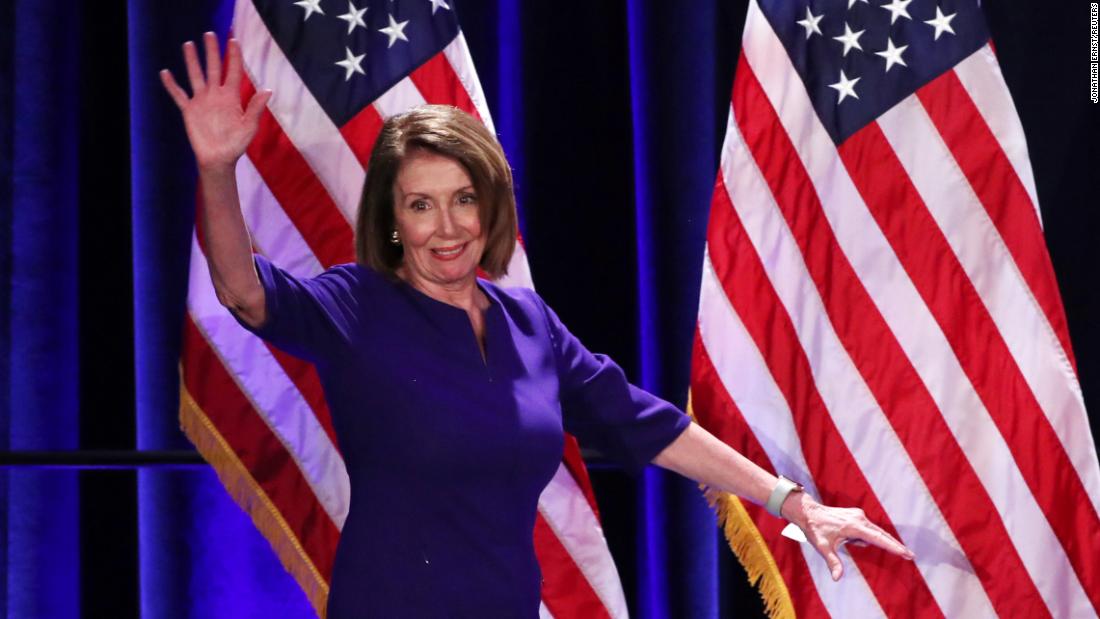Washington (CNN)Donald Trump made the 2018 midterms all about him.
The result — Democrats sweeping Republicans out of power in the House and expanding their hold on the Senate — illustrated the rewards and limitations of his all-base, all-the-time strategy.
His nearly a dozen rallies in the final days of the campaign ensured his hardline immigration message would dominate, even if Republican candidates in key areas were running away from just that.
“He’s like Journey who won’t stop playing “Don’t Stop Believing,’” said a top Republican operative working on House races. “He only plays the same song to his base, every tweet is basically the same, he only trusts what got him the presidency in unique circumstances in 2016.”
This source added: “And it really, really hurt us when you don’t have the most unlikeable person ever to run for president against him,” referencing Hillary Clinton in 2016.
But on the Senate side, Trump appeared to be a boon to Republicans running to unseat Democratic incumbents in states he won in 2016.
“It could have been a lot worse and by all indications, it should have been a lot worse,” said Rick Gorka, deputy communications director in at the Republican National Committee. “But what we have is a pretty typical night in the House and a very not typical night in the Senate where we are knocking off incumbents.”
Over the final week of the campaign, Trump headlined 11 rallies in eight states. As the dust settles on Tuesday night’s contests, Trump’s winning percentage in statewide races in those states was overwhelmingly positive.
The president traveled to Florida, Indiana and Missouri twice in the final week, all states where Republicans notched high profile wins. Republican Ron DeSantis defeated Democratic mayor Andrew Gillum in the Florida gubernatorial contest, while Gov. Rick Scott currently leads Democratic Sen. Bill Nelson in the Senate contest. And the Republicans in Indiana and Missouri both ousted Democratic Senate incumbents.
Trump also traveled to Tennessee, where Republican Rep. Marsha Blackburn trounced Democrat Phil Bredesen and Georgia where Republican Brian Kemp is leading Democrat Stacey Abrams in the state’s gubernatorial contest.
Trump’s only clear losses in top state-wide races were in West Virginia, where the President was unable to propel Republican Patrick Morrisey, a candidate even Republicans believed was underwhelming, past Democrat Joe Manchin, and Montana, where Democrat incumbent Sen. Jon Tester defeated Republican Matt Rosendale.
“We saw the candidates that I supported achieve tremendous success last night,” Trump told reporters on Wednesday. “This vigorous campaigning stopped the blue wave.”
He added: “History really will see what a good job we did in the final couple of weeks in terms of getting some tremendous people over the finish line.”
That, however, is where the good news ends for the President, because last night’s election also ushered in an empowered opposition party in the House, with Democrats sweeping into the majority through clear victories in the nation’s suburbs.
But when you broaden out his travel, it became clear that his success rate wasn’t as stellar: He traveled to Wisconsin, where both the Republican gubernatorial and Senate candidate lost; Nevada, where Democrats won the governor’s mansion and Senate seat; and Arizona, where the race remains neck-and-neck.
While suburban wins by Democrats were expected — especially outside liberal cities like Philadelphia, Washington, DC, and Denver — the party also rose deep Trump antipathy to suburban wins in red states with victories around Oklahoma City, Oklahoma; Charleston, South Carolina and Dallas, Texas.
And Trump’s Twitter endorsements — which were largely just a copy and paste job on gun, crime and immigration policy — meant very little. The President endorsed Nevada’s Danny Tarkanian, New York’s Dan Donovan and Kansas’ Kevin Yoder, all of whom lost. Trump, from Saturday to Tuesday, backed 33 candidates on Twitter — 16 lost and 12 won.
Trump did wait to gloat on Wednesday, slamming those Republican lawmakers by name who didn’t “embrace” him during their campaigns.
“They did very poorly. I am not sure if I should be happy or sad, but I feel just fine about it,” Trump said about lawmakers like Mike Coffman in Colorado, Barbara Comstock in Virginia and Mia Love in Utah. (CNN has not projected a winner in Love’s race)
“Mia Love gave me no love. Too bad. Sorry Mia,” he said. “Those are some of the people that decided for their own reasons not to embrace, whether it is me or what we stand for, but what we stand for meant a lot of most people.”
This reflected a growing sense inside the White House in the weeks leading up to the midterms, where top White House officials were keeping tabs on those Republicans who tried to distance themselves from the President.
Asked what he learned from the results last night, Trump simply stated, “I think people like me, I think they like the job that I am doing.”
Unmentioned by Trump, however, are those House candidates the President did campaign with who later lost, like Katie Arrington in Charleston, South Carolina, who lost to Democrat Joe Cunningham, making him the first Democrat to hold the seat since 1981.
And in Republican circles, that desire by Trump to spurn those who didn’t stand with him was worrying and got directly to his struggles with suburban women.
“This is why he struggles. He can’t help himself,” said a former White House official. Suburban women “see it as childish and adolescent. They expect their children to act that way, not the President of the United States.”
What was striking on Wednesday was how both sides that lost on Tuesday — Democrats who failed to hold or make ground in the Senate and Republicans who failed to keep the House — partially blamed Trump’s closing message on immigration, primarily though nativist comments about a caravan of migrants moving through Mexico and the need to end birthright citizenship, and his concert-like rallies in key states for their losses.
“They made it about us versus them, Democrat versus Republican, nationalizing these races and not necessarily about the records of either candidate,” said a senior Democrat working on Senate race. “It became just a D vs. a R. And these were heavily Trump states.”
They added: “That’s what helps in Missouri, Indiana and Tennessee, but it hurts in the House. So that is why there is this dichotomy.”
This became clear to Republicans on the ground in key swing House districts after Trump made much watched visits. For example, Republicans with knowledge of internal numbers said Trump had a negative impact on GOP incumbent Rep. John Culberson after his Houston rally for Sen. Ted Cruz in October. Culberson lost on Tuesday night.
Democrats, for the most past, ignored Trump on the ground in key swing districts, instead choosing to focus on policy issues related to the President — namely health care and taxes. But what Trump created, according to top Democrats, was wild uncertainty with his eye-catching rallies and frenetic messaging.
“One of the key pieces we had learned over the last two years of watching Trump is there is an opposite and equal reaction across the country whenever he does something,” said Dan Sena, executive director of the Democratic Congressional Campaign Committee. “We call it shaking the snow globe. … There was an opposite reaction in highly suburban areas, and we were there to capitalize on it.”



